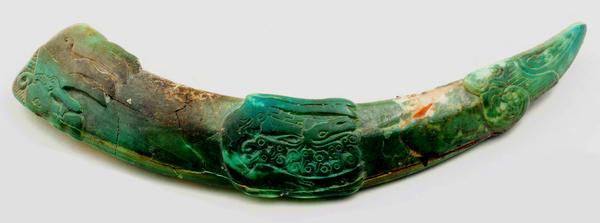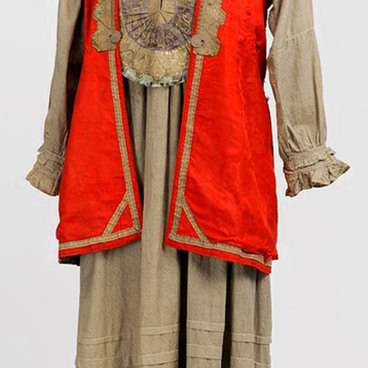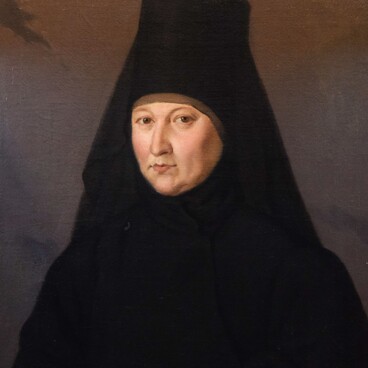This amulet fashioned from a boar’s tusk is from the early Iron Age. An image of a bird’s head with an outstretched beak is carved into the amulet’s narrow end. The maxilla (the top half of a bird’s beak) is sharply defined and decorated with horizontal etching. The eye is made up of a six-petalled rose flower. Within the image of the bird it is possible to see the outline of a moose’s head with a crooked nose, a teardrop-shaped eye and a long triangular ear.
The central section of the amulet is decorated with a carved figure of a deer drinking water. It’s back is arched, with the front of the animal looking behind itself. Its head is low down, between the front and hind legs. The deer’s snout is long, its eye is shaped like a teardrop, and its ear is shaped like a long triangle, pressed up against its neck. Its antlers cross over, forming the shape of an eagle’s head with elaborate round eyes. They come together to form the ornament. A saiga (antelope) head with its characteristically curved nose is depicted at the base of the deer’s neck. The male saiga’s characteristically spiral horns are clearly visible.
A fully grown boar is carved into the wider end of the amulet, standing on the tips of its hooves. Its head is lowered, its fanged mouth is slightly open and its ear looks like a curl. The opposite side of the tusk has a smooth surface with a slot at the wider end.
It is common to see hoofed animals depicted on Savromat-Sarmatian objects, whether fully or only partially shown. Wild animals such as deer, moose, mountain goats, saigas or boars were also included in the designs. Birds of prey were common tropes in the art produced between the 6th-5th centuries BC. The image of the bird’s head was often ornamented with elements of bridle equipment.
This amulet was discovered by archeologist Evgeny Maksimov whilst examining a burial mound near the village Novo-Privolnoye, in Saratov Region. It was discovered amongst ornaments for a horse harness, including bronze plaques stylishly made to look like wolves, bears, owls and other animals. There were three tusk amulets: two wider and one narrower. The widest tusk amulet is distinguished by having the most exuberant decoration of the three.
The central section of the amulet is decorated with a carved figure of a deer drinking water. It’s back is arched, with the front of the animal looking behind itself. Its head is low down, between the front and hind legs. The deer’s snout is long, its eye is shaped like a teardrop, and its ear is shaped like a long triangle, pressed up against its neck. Its antlers cross over, forming the shape of an eagle’s head with elaborate round eyes. They come together to form the ornament. A saiga (antelope) head with its characteristically curved nose is depicted at the base of the deer’s neck. The male saiga’s characteristically spiral horns are clearly visible.
A fully grown boar is carved into the wider end of the amulet, standing on the tips of its hooves. Its head is lowered, its fanged mouth is slightly open and its ear looks like a curl. The opposite side of the tusk has a smooth surface with a slot at the wider end.
It is common to see hoofed animals depicted on Savromat-Sarmatian objects, whether fully or only partially shown. Wild animals such as deer, moose, mountain goats, saigas or boars were also included in the designs. Birds of prey were common tropes in the art produced between the 6th-5th centuries BC. The image of the bird’s head was often ornamented with elements of bridle equipment.
This amulet was discovered by archeologist Evgeny Maksimov whilst examining a burial mound near the village Novo-Privolnoye, in Saratov Region. It was discovered amongst ornaments for a horse harness, including bronze plaques stylishly made to look like wolves, bears, owls and other animals. There were three tusk amulets: two wider and one narrower. The widest tusk amulet is distinguished by having the most exuberant decoration of the three.



